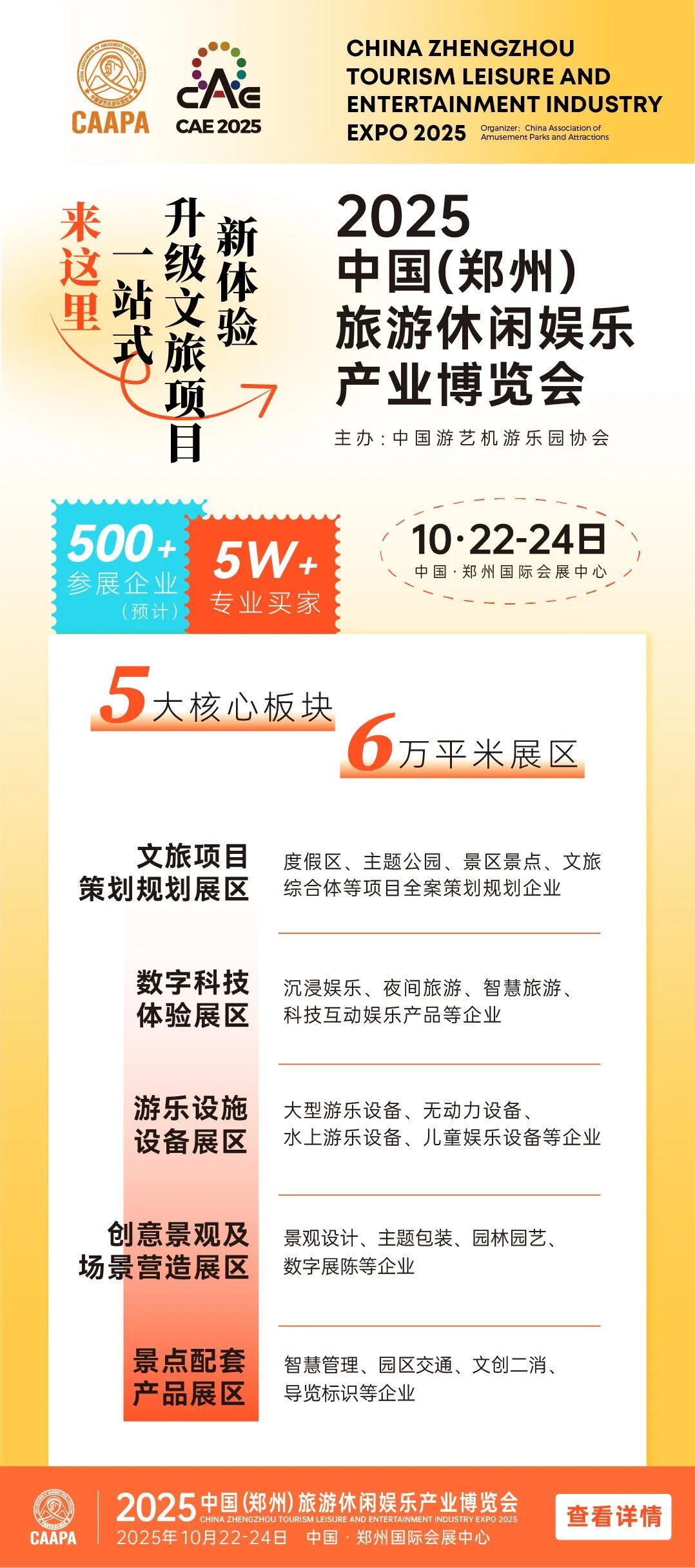
The ultimate goal of cultural and tourism projects—The Infinite Game!
Source:
Author:
Release time:
2025-09-25
Click to view details



Come here ↓ to discover new trends in culture and tourism
2025 China Tourism, Leisure, and Entertainment Industry Development Conference
Join forces with over 1,000 leading cultural and tourism enterprises to celebrate this grand event and seize the opportunities together.
See you in Zhengzhou from October 21 to 23!
<< Swipe left or right to view event details >>
▲
Editor-in-Chief | Yang Ming
“Never coming back,” is often the first thing tourists say as they step out through the park’s gates.
Philosopher James Carse, in "Finite and Infinite Games," says: "A finite game is played for the sake of winning, while an infinite game is played for the sake of continuing the play."
For cultural and tourism projects, the ultimate goal is the infinite game. The infinite game has no clear endpoint—its sole objective is to keep the game going forever.
The "Lifecycle Anxiety" in the Culture and Tourism Industry
Many traditional cultural and tourism projects have, from the very beginning, fallen into a "limited-game" mindset: inflated ticket prices, cookie-cutter attractions, and overly commercialized landmarks... Tourists arrive full of anticipation, only to depart with the firm resolve never to return.
Cultural and tourism projects conceived with limited thinking are like carefully packaged fast-moving consumer goods, following a standardized "decline formula":
The hardware-driven path dependency. At the heart of the issue with these antique-style towns lies the fact that the project treats "restoring ancient architecture" as its ultimate goal, while neglecting the true soul of these historic towns: the vibrant, living essence of daily life. This investment-heavy model is, in essence, a limited game whose sole objective is to achieve "opening-day metrics"—and once the initial investment starts yielding returns, the "game" effectively comes to an end.
A zero-sum game of homogenized competition. In Shuanglang Ancient Town, Dali, Yunnan—once catapulted into fame by the hit drama "Go to a Place with Wind"—over 200 trendy, social-media-famous guesthouses and more than 300 cafes have sprung up within just three years. Yet as every project scrambles to attract "the same type of tourists," all caught in a limited-game dynamic of "outdoing each other in marketing," the entire industry has fallen into a "prisoner's dilemma." Each participant knows that this relentless pursuit of homogeneity is unsustainable—but no one dares to pull back, because doing so would mean being left behind.
KPI-driven short-termism. An overly rigid performance evaluation system forces frontline managers to adopt an "overkill" approach to operations—essentially sacrificing long-term sustainability for immediate gains. While this "numbers game" delivers impressive financial reports in the short term, it ultimately drains the vitality of the projects. When visitors start voting with their feet, the so-called "growth myth" collapses in an instant.
The fundamental paradox of limited games lies in their definition of "victory" as an endpoint—yet they fail to recognize that the very essence of culture and tourism resides precisely in "having no终点." When a scenic area treats "successful opening" as its ultimate goal, it inherently forfeits the possibility of continuous evolution.

The core of the infinite game—
The "Life Force Code" of Cultural and Tourism Projects
For cultural and tourism projects, achieving an "infinite game" means building an ecosystem that can self- renew and sustain continuous growth.
Dynamic, iterative experience design. Kumamon, the beloved IP from Kumamoto Prefecture in Japan, is a prime example of an "infinite game." This mascot, created by the local government, doesn’t just stay at the level of a "cute image"—instead, it continuously fuels its popularity by crafting engaging "story-driven events": In 2013, Kumamon was given the official identity of a "civil servant," complete with a daily work log; in 2015, a "disappearance incident" was staged, sparking a nationwide search across Japan; and in 2020, the "Kumamon Transformation Project" was launched, allowing the character’s appearance to evolve regularly based on suggestions from fans online. More importantly, all commercial revenues generated by Kumamon are reinvested into Kumamoto’s post-disaster reconstruction efforts, creating a virtuous cycle of "IP-driven value—social impact—sustainable IP growth." This innovative design, which deeply intertwines commercial and social value, has unlocked limitless potential for Kumamon’s enduring success.
A symbiotic and co-creative community ecosystem. Zhejiang's Songyang "Ming and Qing Old Street" has steered clear of the conventional path of commercial land development, instead embracing the concept of a "Living Museum": preserving the authentic living scenes of local residents, supporting the legacy and innovation of time-honored shops (such as the century-old tofu workshop that now crafts "tofu ice cream"), inviting artists to create on-site, and even training elderly locals to serve as "living tour guides." Visitors here can not only immerse themselves in traditional marketplace life but also actively participate in interactive experiences like "Learn to Make Songyang Braised Duck" or "Pick Tea Leaves with Local Farmers." This symbiotic model, which engages tourists, residents, and merchants as equal partners, has transformed the old street from a mere "static attraction" into a vibrant, thriving "living entity."
A brand belief guided by values. New Zealand's Cape Reinga scenic area boasts no commercial facilities yet remains one of the country's most iconic tourist destinations. Here, Māori guides share the legendary tale of "souls returning to their ancestral lands," while environmental volunteers invite visitors to join in dune conservation efforts. Meanwhile, scientists take the opportunity to educate guests on the critical importance of ecological balance. At its core, the area’s true value lies not in "fun" but in fostering a profound "connection between people and nature." This unique ethos has cultivated a powerful brand identity: visitors come not to simply consume, but to actively engage in a meaningful dialogue about the very essence of life itself.
The core logic of the infinite game is that "growth" itself is the ultimate goal. Cultural and tourism projects aren’t about creating a "perfect product" once and for all—but rather about building a "space that will always be worth exploring." In this space, every visitor can uncover new meaning, and each return brings fresh experiences, ensuring the project’s vitality continues to flourish over time.
The "Evolutionary Methodology" of Cultural and Tourism Projects
An infinite game has no endpoint, but it does have its own rules of operation. For cultural and tourism projects to achieve an "infinite game," they must establish the following mechanisms:
1. Content can be updated, keeping the destination "forever unfinished."
Traditional attractions remain unchanged for years once built, whereas infinite-game-style cultural and tourism projects must embrace "dynamic growth."
Regularly introducing new content: art exhibitions, music festivals, themed markets, seasonally limited events…
Leave the blank spaces open—let visitors and creators fill them together. Examples include "Fan-Co-created Itineraries" and "User-Generated Content Initiatives," among others.
2. Users can get involved, transforming from "consumers" into "players."
In the infinite game, everyone is a participant.
Design mechanisms to encourage visitors to contribute content—such as recording travel stories via an app, launching offline exploration missions, or inviting locals to engage in conversations with tourists.
Establish a feedback loop: Ensure that visitors' opinions truly influence the evolution of the scenic area.
3. Ecologically scalable, a cultural and tourism community that transcends geographical boundaries
The infinite game of culture and tourism doesn’t stop at "within the scenic area"—it should extend online, into surrounding communities, and even into the lives of visitors after they return home.
Online experience continuation: Stay connected through virtual tours, social media interactions, and other engaging methods;
Empowering Local Culture: Transforming cultural and tourism projects into "amplifiers" of local culture, rather than "destroyers."
4. The model is cyclical, fostering a dual positive feedback loop of economic and social value.
Limited games pursue short-term ROI (return on investment), while unlimited games focus on long-term value—including economic gains, social recognition, and cultural influence, among others.
For example: Instead of relying on ticket sales, it generates revenue through multiple channels such as accommodation, dining, cultural and creative products, and membership programs.
At the same time, prioritize environmental protection, cultural preservation, and community empowerment to achieve sustainable development.
From finite games to infinite games, the underlying mindset of cultural and tourism projects must undergo the following transformation:
The core competitiveness of cultural and tourism projects is The ability to "continuously create new meaning" 。 In finite games, competitiveness manifests as "resource advantage"—whoever has the better location, greater investment, and fresher ideas. In infinite games, however, competitiveness shifts to "the ability to create meaning"—specifically, who can continually offer visitors new reasons to explore.
The role of tourists is not "Not consumers," but rather "players" and "co-creators." 。 Traditional cultural and tourism experiences define tourists as "passive consumers who simply receive services," whereas the Infinite Game approach invites visitors to become "active players who engage in the experience." When tourists shift from being "bystanders" to "participants," cultural and tourism projects gain an intrinsic, self-sustaining momentum for growth.
The essence of cultural and tourism operations is to build "Value Network" rather than "Transaction Relationship" 。 Limited games aim to maximize the "one-time transaction value" with visitors, while unlimited games focus on building a "long-term value network." Ultimately, the moat that safeguards cultural and tourism projects is an irreplaceable relationship network.
The ultimate goal of cultural and tourism development is to achieve "The Symbiosis of Individual Growth and Social Progress" 。 The boundaries of the infinite game don’t stop at commercial success—they extend to broader societal values. When cultural and tourism projects become deeply intertwined with urban development and social progress, they gain a sustained momentum that transcends mere commerce. And this, indeed, is the ultimate meaning of the infinite game.
James Carse wrote in "Finite and Infinite Games": "An infinite player never claims victory, for he knows the game is always ongoing."
The ultimate goal of cultural and tourism projects is to become precisely this kind of infinite game—one that doesn’t strive for one-time maximization, but rather seeks perpetual self-evolution. It doesn’t deplete resources; instead, it thrives in symbiosis with them, even going so far as to create new resources. At its core, it’s not about “transactions,” but about “relationships”—relationships with the land, with people, and with time itself.
( The article expresses only the author's views and does not represent the platform's stance. Feel free to leave a comment and engage in a discussion with the author! )
Come here ↓ to discover great cultural and tourism content
2025 China (Zhengzhou) Tourism, Leisure, and Entertainment Industry Expo
500+ Exhibiting companies are here to help you One-stop Build and upgrade Culture and Tourism Project
Key words:















